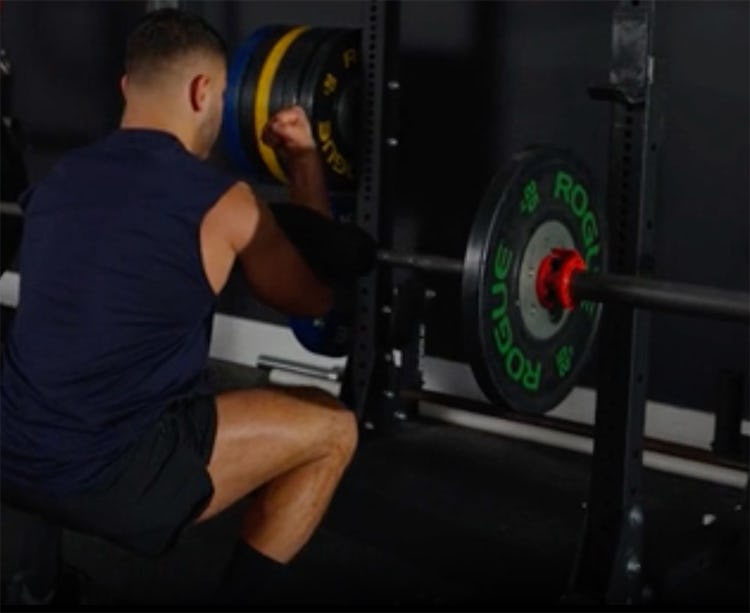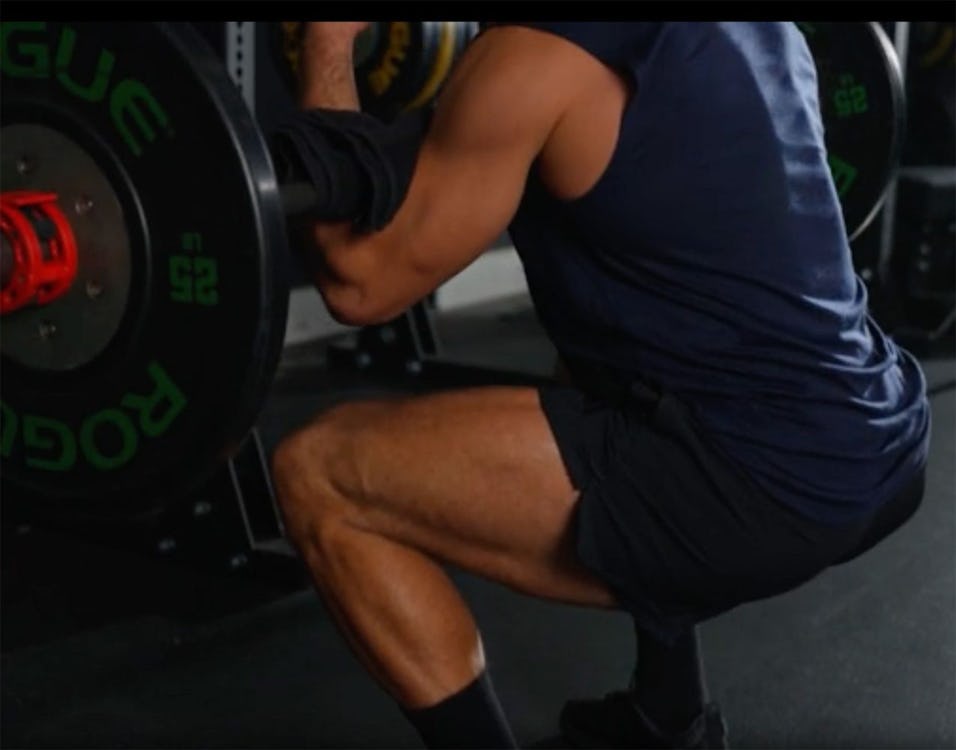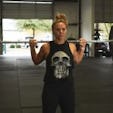The Zercher squat can offer a low back-friendly alternative to back squats that also prepares you for sports like strongman competition or MMA. Here’s how to do it right and incorporate it into your routine.
What Are The Benefits of Doing The Zercher Squat?
(See 00:25 in the video above)
The Zercher squat gets its funny name from a strongman named Ed Zercher. The rumor is that Zercher didn’t have a squat rack in his gym, so, rather than squat with a bar on his back, he had to place the barbell on the floor and then bend down and hook his arms under it to lift the bar into position at his belly. Today, many lifters do Zercher squats using a squat rack, but they perform the same basic movement, holding the bar in front of their body, in the bend of their elbows.
A Zercher squat is very similar to a kettlebell goblet squat or a barbell front squat, in that it allows you to squat with a very upright torso, and therefore squat very deep. Because the weight is loaded on the front of your body, your core and upper back have to work really hard to stabilize you. The Zercher squat is much easier on the lower back than a back squat is, so it’s a good alternative if you’re dealing with an injury. In a back squat, your torso inevitably will bend a little toward the floor, and that places shear forces on the spine. If you have back problems already, this can make things worse. The Zercher squat allows you to keep your joints stacked, minimizing stress on the low back.
You could also argue that Zercher squats are a good choice for wrestlers and other combat athletes who have to pick people up from time to time, as they mimic that movement. They’re also applicable to strongman competitors who have to perform events like the Conan’s Wheel, or stone carries, as they more closely resemble those movements than other types of squats.
Of course, if you don’t have a squat rack but you want to do barbell squats at home, you can do what Zercher did and get the bar up to your chest from the floor—that is, IF you have the mobility to pick the bar up safely.
How To Do The Zercher Squat Correctly

(See 02:02 in the video.)
The safest way to perform a Zercher squat is to take the bar out of a squat rack.
Step 1. Set the bar in the rack at about stomach height. Now hook your arms underneath it so that the bar rests in the bend of your elbows. This can be very uncomfortable, so it’s a good idea to wear a long-sleeve sweatshirt when you do these, or wrap a towel around the bar to cushion your arms.
Step 2. Scoop the bar out of the rack, step back, and stand with your feet between hip and shoulder width, just as you would for a normal back or front squat. Turn your toes out about 30 degrees. Make sure your arms are close to the center of the bar, so it’s balanced. You can cup one hand over the other, or have your forearms parallel to each other with your hands in fists—whichever is more comfortable. In either case, your arms should look like they’re in the top position of a curl. Your biceps are fully shortened, but they aren’t really working against the resistance of the bar. You’re just using your arms as hooks to hold the bar in place. You shouldn’t feel your shoulders working. If you do, your elbows are probably too high.
Step 3. Take a deep breath into your belly and brace your core. Keeping your torso very tall and straight, squat as deeply as you can without losing the arch in your lower back (in other words, don’t let your pelvis tuck under). Think of the movement as being like a goblet or front squat. Push your knees apart as you descend so that your elbows fit between them.
Step 4. After you’ve descended to your safest squat depth, come back up and stand tall.
If you don’t have a squat rack, you can deadlift the bar off the floor and into your lap, and then hook your arms underneath the bar and stand up to get into position. Note that this approach will require a lot of hip mobility so that you don’t round your lower back, so it’s not appropriate for most people. However, if you’re sure you can do it safely, make sure you use a very light weight at first.
In strongman competition, the Zercher squat and similar exercises (such as Zercher carries, or the Conan’s Wheel) are typically done with an axel rather than a conventional barbell. Axel bars are available in some gyms, and their diameter is much thicker than that of a standard barbell. If you have access to one, the axel bar is a good choice for Zercher exercises, as it not only better mimics how you would do them in strongman but also offers the biceps and elbows some relief. The thickness of an axel spreads the load across your elbows, so it doesn’t bite into them the way a narrower bar does.
What Muscles Does The Zercher Squat Work?
(See 04:20 in the video.)
The Zercher squat works the same muscles that virtually every other squat works, including the quads, glutes, and adductors. Because the weight is loaded in front of you, it’s going to be even more demanding on your abs and obliques—your core muscles—than a back squat would be. Your upper back will also have to work really hard to keep the bar from falling. Yes, your biceps will help out as well just keeping the bar in place, but it’s an exaggeration to say that they really get trained by Zercher squats. If you want to get bigger, stronger arms, you’re better off doing curls!
The Zercher Squat Vs. Front & Back Squats
(See 04:55 in the video.)
The Zercher squat is very similar to a front squat. You’re just holding the bar in a different place, but it will work the same muscles and feel similar. If you have trouble doing Olympic-style front squats because they bother your wrists, the Zercher squat could be a good alternative. The Zercher squat is also easier on your lower back and shoulders than a back squat would be, but because you have to rely on your arms to hold the bar in front of you, you’re not in as strong of a position doing Zercher squats as you would be doing either the front or back squat. You will be limited by your core and back strength, as well as your arms’ ability to hold the weight. Therefore, you won’t be able to train Zercher squats as heavy as those other lifts.
How To Stretch Before Doing Squats
Try out these warmup and mobility moves from Onnit’s Director of Fitness Education, Shane Heins, before attempting a Zercher squat workout.
Alternatives To The Zercher Squat
(See 05:38 in the Zercher Squat video at the top.)
Again, because the Zercher squat is so similar to front squats and goblet squats, try those movements if you want to get the feel of Zercher squats but don’t feel up to actually doing them just yet.
Front Squat
(See 05:53 in the Zercher Squat video.)
Step 1. Grasp the bar with hands shoulder-width apart and point your elbows forward so that you can position the bar over the tips of your fingers (palms face up). As long as you keep your elbows pointing forward, you will be able to balance the bar.
Another way to do it is to cross your arms in front of you, holding the bar on the front of your shoulders (left hand in front of right shoulder, right hand in front of left). To do the classic front squat with the bar on your fingertips, you need a reasonable amount of flexibility through your shoulders and wrists to position the barbell correctly. If you don’t have it, the cross-arm version may be the better option for you at the moment.
Step 2. Lift the bar out of the rack and step back, setting your feet between hip- and shoulder-width apart. Turn your toes out slightly. Pull your ribs down and take a deep breath into your belly and brace your core. Your head, spine, and pelvis should form a long line—your pelvis should also be perpendicular to your spine, and not tilted toward the floor. Focus your eyes on a point straight in front of you.
Step 3. Squat as low as you can while keeping alignment and maintaining your upright torso position. Remember to point your elbows forward, and raise them up if you feel them slipping downward. Ideally, you’ll be able to descend to where the crease of your hips is below the top of your thighs.
Step 4. Extend your hips and knees to return to standing, pushing through the middle of your feet and squeezing your glutes.
Goblet Squat
(See 07:30 in the Zercher Squat video.)
Step 1. Hold a kettlebell in front of your chest by the sides of its handle. Draw your shoulders back and downward (think: “proud chest”), and tuck your elbows in close to the bell—try to get your forearms as vertical as you can. Stand with your feet between hip- and shoulder-width apart, and turn your toes out a bit—up to 30 degrees if you need to.
Step 2. Tuck your tailbone and draw your ribs down so that your pelvis is parallel to the floor. Take a deep breath into your belly, and brace your core.
Step 3. Keeping a long spine from your head to your pelvis, push your hips back and squat down, as if sitting down into a chair. Squat as low as you can while keeping your head, spine, and pelvis aligned. Push your knees apart as you descend. You should feel most of your weight on your heels to mid-foot area. If you feel your lower back beginning to round, stop there, and come back up. Keep your torso as vertical as possible—you shouldn’t have to lean forward or work extra hard to hold the bell upright. Avoid bending or twisting to either side.
Step 4. Drive through your feet as you extend your hips and knees to come up.
How To Fit The Zercher Squat Into Your Workout
(See 09:26 in the video.)
The Zercher squat can be a good alternative to front squats, especially if you want to train more like a strongman or prepare your body for heavy carrying of any kind. It’s also a good substitute for back squats if you’re having lower-back issues. Understand, however, that you won’t be able to train as heavy with the Zercher squat as with other squat variations, and that can be detrimental if you want to build maximum strength or leg muscle. With that said, Zerchers have been around 100 years or more for good reason: they build very functional, real-world strength throughout your whole body.
Do them toward the beginning of your leg or full-body workout when you’re at your freshest. Since the Zercher squat has you squatting so upright, it’s going to let you squat very deep, and that places most of the emphasis on your quads. Be sure to balance it out with other exercises that work the hamstrings and glutes just as hard. Two to three sets of 5–10 reps is good to start, progressing the weight and rep numbers over time.

)





